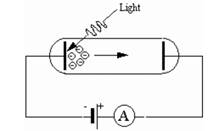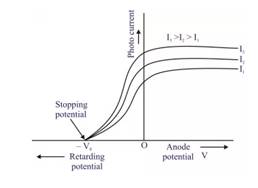(a) Define the terms, (i) threshold frequency and (ii) stopping potential in photoelectric effect.
(b) Plot a graph of photocurrent versus anode potential for a radiation of frequency v and intensities I1 and I2 (I1 < I2).
(a)(i)Threshold frequency- Threshold frequency is defined as the lowest frequency that is required for emission of electrons from a metal surface when an electromagnetic radiation falls on the metal surface.
(ii)Stopping potential-

Stopping potential is defined as the potential necessary to stop even the electrons with the most kinetic energy from reaching the other side of the conductor.
(b)

Explanation:
The starting point of both lines are from same –ive potential that is also called as stopping potential and defined as smallest magnitude of the anode potential which just stops photocurrent is called as stopping potential.
Mathematically
Work done by external voltage ![]() and this should be equal the Kinetic energy of electron which just fails to reach anode whose K.E will be given as
and this should be equal the Kinetic energy of electron which just fails to reach anode whose K.E will be given as ![]()
Where ![]() is work function of metal.
is work function of metal.
Equating it we get
![]()
![]()
We can see the stopping potential doesn’t depend upon intensity of light rather does only depend upon wavelength of light and work function of metal.
And saturation current for higher intensity of light is more because as the no. Of photons falling on the metal increases more of the electrons interact with it and escapes the metal thus increasing the saturation current.